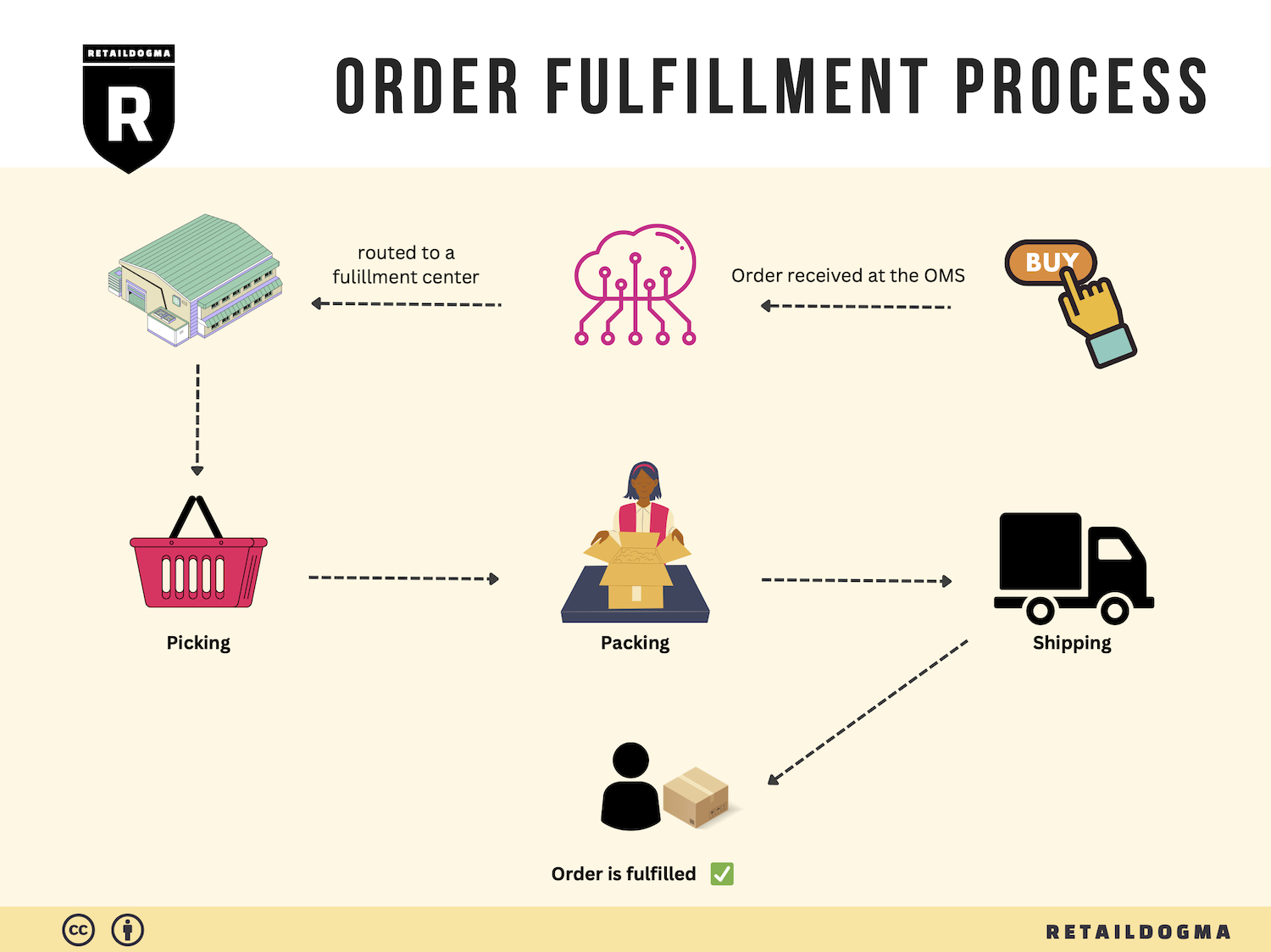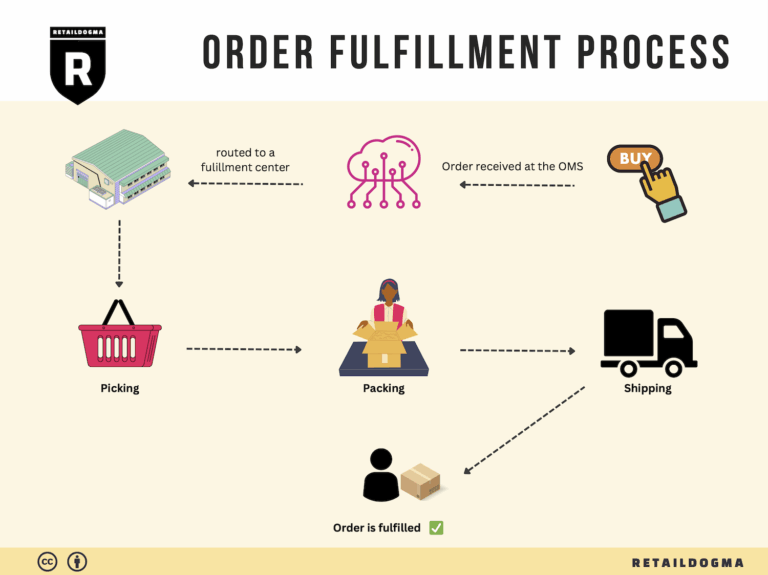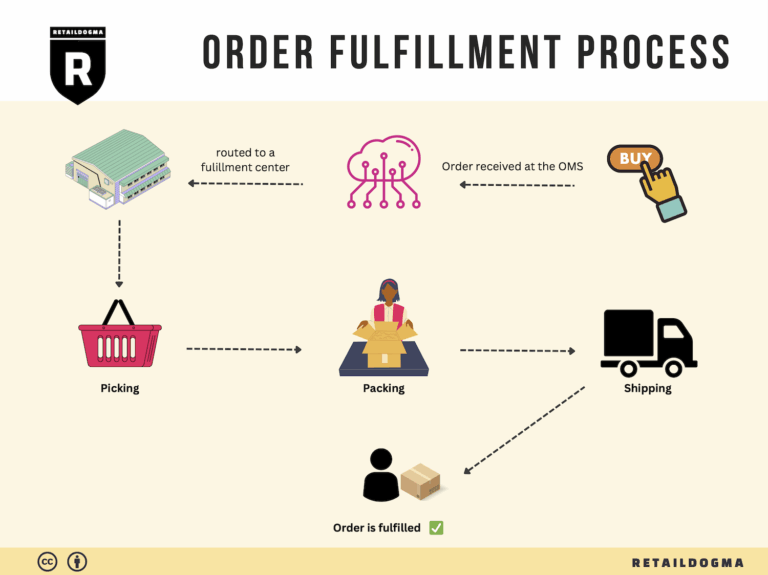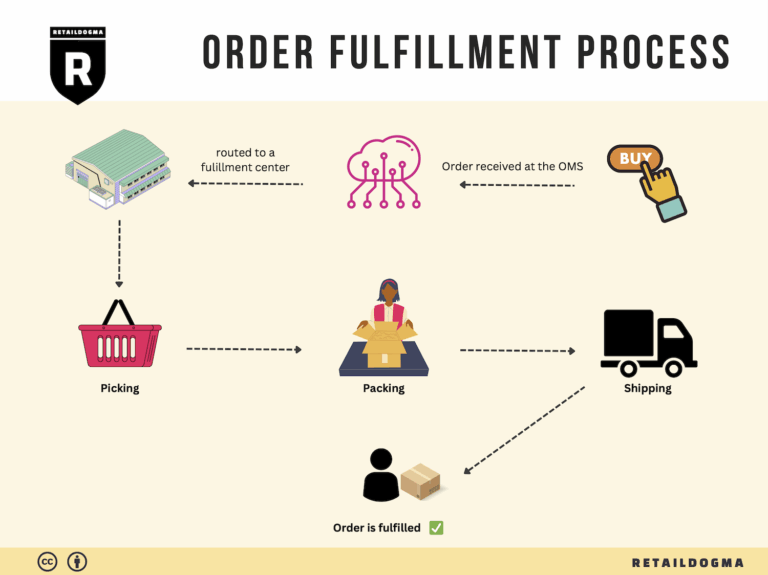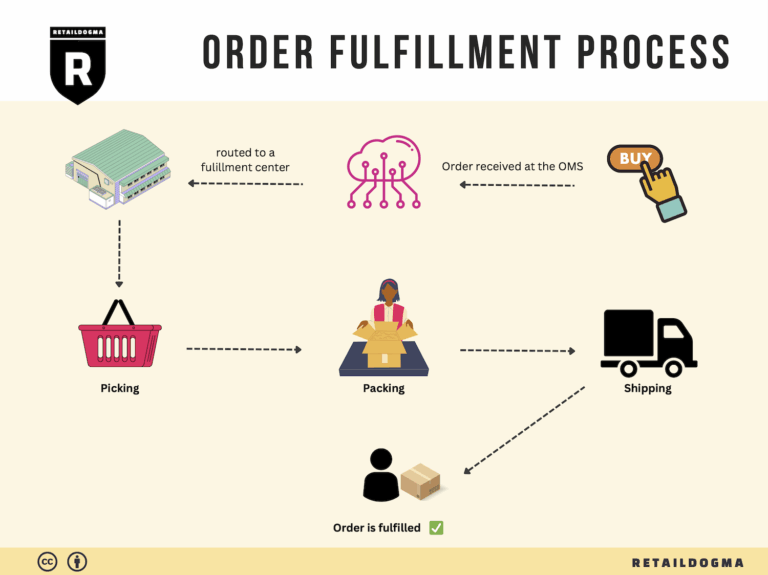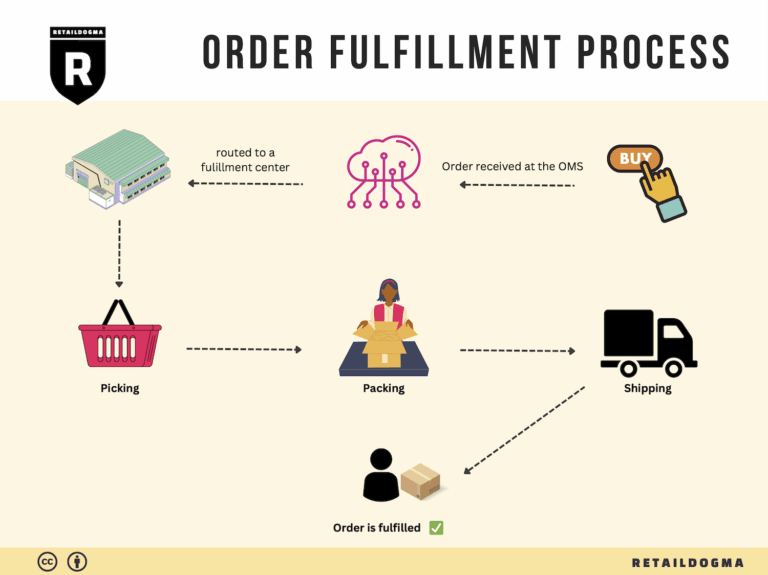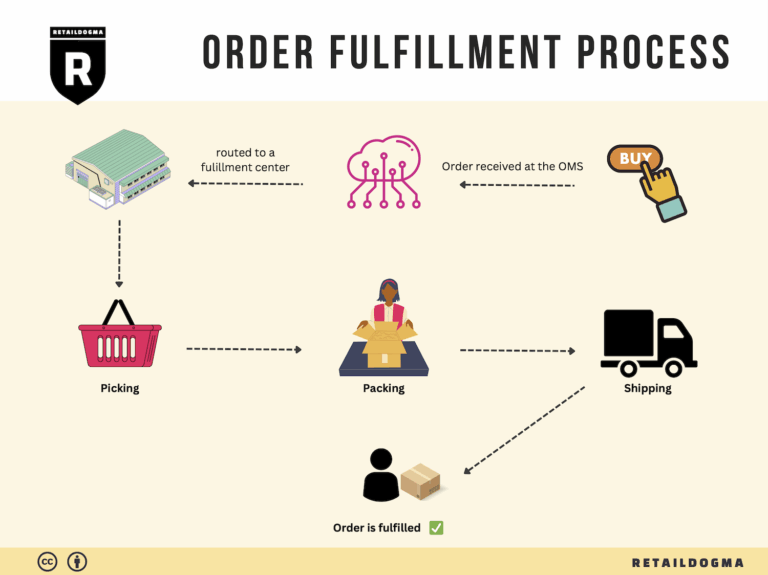Ecommerce Fulfillment Services: The Ultimate Guide (2025)
What is E-commerce Fulfillment? An Introduction for Growing Businesses
Understanding the Challenge of E-commerce Fulfillment
As an e-commerce business owner, you may often feel overwhelmed by the logistics of packing and shipping orders. The thrill of making sales can quickly turn into a logistical nightmare when faced with the demands of fulfilling those orders efficiently and accurately. This is a common pain point for growing online businesses, where the transition from small-scale operations to a larger, more complex fulfillment process can create significant stress and operational challenges.
Defining E-commerce Fulfillment
At its core, e-commerce fulfillment is the process of getting a product into the hands of a customer. This encompasses everything from receiving inventory and storing products, to picking, packing, and shipping orders. As your business scales, the intricacies of this process can become daunting, making it crucial to understand the various fulfillment models available to you.
What This Guide Will Cover
In this guide, we will explore the different e-commerce fulfillment models, such as Third-Party Logistics (3PL) and Fulfillment by Amazon (FBA). Each model offers distinct advantages and challenges, which we will clarify to help you determine the best fit for your business.
Additionally, we will delve into the core services that fulfillment partners typically provide. These services can include inventory management, order processing, shipping logistics, and customer service support. Understanding these elements will enable you to assess the capabilities of potential fulfillment partners effectively.
Choosing the right fulfillment partner is critical for your business’s success. We will outline the key criteria to consider, including reliability, scalability, technology integration, and customer service. These factors will help you evaluate potential partners and make informed decisions.
Pricing is another vital aspect of fulfillment that we will address. We will break down the various costs associated with different fulfillment models, helping you to understand how to budget and plan for these expenses as your business grows.
Empowering Smart Logistics Decisions
The goal of this guide is to empower you to make smart decisions about your logistics strategy. By understanding the nuances of e-commerce fulfillment, you will be better equipped to streamline your operations, enhance customer satisfaction, and ultimately drive growth. As you navigate this essential aspect of your business, remember that effective fulfillment can be a significant competitive advantage in the crowded e-commerce landscape.
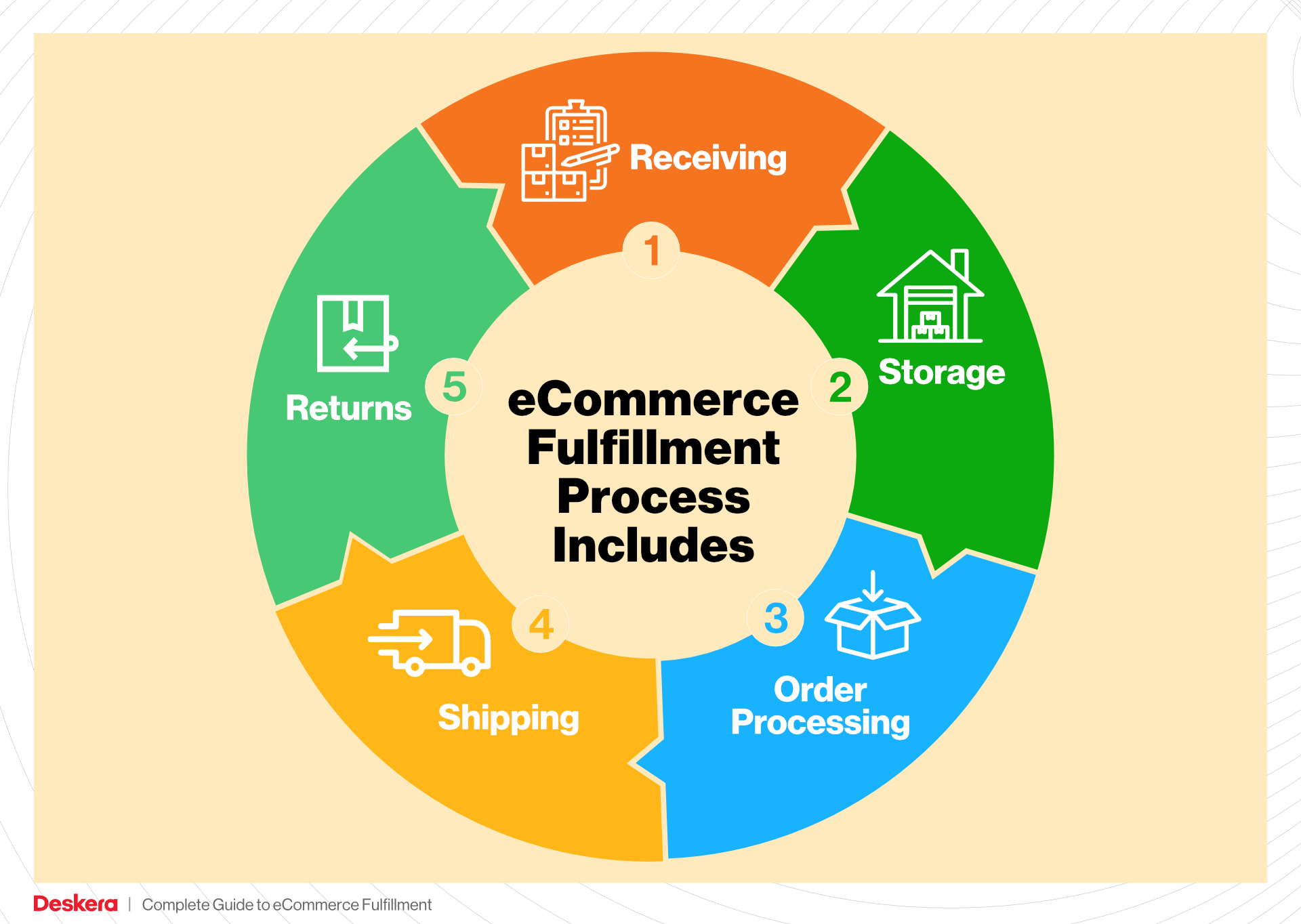
What You’ll Learn In This Guide
- What is E-commerce Fulfillment? An Introduction for Growing Businesses
- The Order Fulfillment Process: From ‘Buy’ Button to Customer’s Door
- Comparing Fulfillment Models: In-House vs. 3PL vs. Dropshipping
- A Deep Dive into Amazon FBA: Pros, Cons, and Who It’s For
- Core Services Offered by Fulfillment Centers
- How to Choose a Fulfillment Partner: A 6-Point Checklist
- Understanding Fulfillment Pricing: A Breakdown of Common Fees
- Frequently Asked Questions (FAQs) about Fulfillment
- Conclusion: Is Outsourcing Fulfillment the Right Move for Your Business?
- Important Disclaimer
The Order Fulfillment Process: From ‘Buy’ Button to Customer’s Door
1. Receiving Inventory
The first step in the order fulfillment process begins with receiving inventory. This involves the acceptance of products from suppliers or manufacturers into the fulfillment center. Upon arrival, each shipment is checked against the purchase order to ensure accuracy in quantity and condition. Key terms associated with this step include SKU (Stock Keeping Unit), which is a unique identifier for each product, allowing for efficient tracking and management within the warehouse.
Importance: Effective inventory receiving is crucial as it sets the foundation for the entire fulfillment process. Any discrepancies at this stage can lead to stockouts, overstocking, or mismanagement, resulting in delays and dissatisfied customers. Furthermore, accurate receiving helps maintain a reliable inventory record, which is essential for forecasting and reordering.
2. Warehouse Storage
Once the inventory is received and verified, the next step is warehouse storage. Products are systematically organized in designated storage areas within the fulfillment center. This organization often utilizes various storage methods, such as shelving, pallet racking, or bin storage, depending on the type and size of the products. A critical term associated with this step is location mapping, which refers to the strategy employed to assign specific locations for each SKU.
Importance: Proper warehouse storage is vital for maximizing space efficiency and ensuring easy access to products. An organized storage system minimizes the time required for order picking and helps prevent stock loss due to misplacement. Moreover, it enhances the overall workflow, allowing employees to navigate the warehouse quickly and effectively.
3. Order Picking
The third step in the fulfillment process is order picking, where warehouse associates retrieve items from storage based on customer orders. This process is often guided by pick lists, which are documents or digital notifications that outline the specific items and quantities needed for each order. Techniques such as batch picking, wave picking, or zone picking may be employed to optimize this process.
Importance: Order picking is a critical operation that directly impacts fulfillment speed and accuracy. The efficiency of this step can significantly affect customer satisfaction, as timely delivery hinges on the quick retrieval of items. Errors during picking, such as selecting the wrong SKU or quantity, can lead to returns and increased operational costs. Therefore, investing in technology, such as barcode scanners or pick-to-light systems, can enhance accuracy and efficiency.
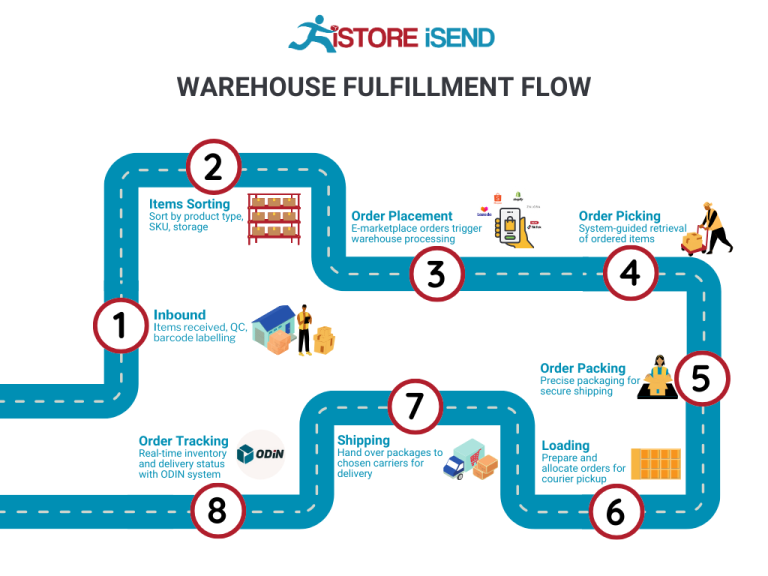
4. Order Packing
After items are picked, they move to the order packing stage. Here, associates prepare the items for shipment by placing them in appropriate packaging materials that protect the products during transit. This step involves using packing slips, which include order details, and may also incorporate shipping labels generated through integrated shipping software.
Importance: Effective packing is essential to ensure that products arrive at the customer’s door in perfect condition. Properly packed orders help reduce damage during shipping and can also enhance the unboxing experience for customers. Additionally, packing plays a role in optimizing shipping costs; using the right size boxes and materials can minimize dimensional weight charges. Businesses must consider sustainability in packing materials as well, aligning with customer preferences for environmentally friendly practices.
5. Shipping & Delivery
The final step in the order fulfillment process is shipping and delivery. Once packed, orders are staged for shipment, which involves scheduling carrier pickups and determining the most efficient shipping methods based on factors like cost, speed, and destination. Key terms in this stage include last-mile delivery, which refers to the final leg of the delivery journey from the distribution center to the customer’s doorstep.
Importance: The shipping and delivery phase is the culmination of the entire fulfillment process and is often when customer satisfaction is most heavily influenced. Timely and reliable delivery can lead to repeat business and positive reviews, while delays or issues can result in lost customers and harm to the brand’s reputation. As e-commerce continues to grow, businesses must explore various shipping options, including same-day delivery and partnerships with local couriers, to meet evolving customer expectations.
In conclusion, understanding and optimizing each step of the order fulfillment process—from receiving inventory to shipping and delivery—are crucial for e-commerce businesses looking to scale operations effectively. By focusing on efficiency, accuracy, and customer satisfaction, businesses can enhance their fulfillment capabilities and drive growth in a competitive marketplace.
Comparing Fulfillment Models: In-House vs. 3PL vs. Dropshipping
Fulfillment Models Comparison
| Model | Who Handles Inventory | Best For (Business Stage) | Key Advantage | Key Disadvantage |
|---|---|---|---|---|
| In-House Fulfillment | The business itself | Established businesses | Full control over inventory and processes | High overhead costs and resource-intensive |
| Third-Party Logistics (3PL) | A third-party logistics provider | Growing businesses | Scalability and reduced operational burden | Less control over inventory and potential service variability |
| Dropshipping | Suppliers or manufacturers | Startups and small businesses | Low startup costs and no inventory management | Lower profit margins and dependency on supplier reliability |
In-House Fulfillment
In-house fulfillment involves managing your own inventory and logistics operations. This model is typically best suited for established businesses that have the resources to handle warehousing, order processing, and shipping. The key advantage of in-house fulfillment is the complete control it provides over inventory management and fulfillment processes. Businesses can tailor their operations to meet specific customer needs, ensure quality control, and respond quickly to market demands. However, this model comes with significant overhead costs. Businesses must invest in warehouse space, staff, technology, and systems for inventory management, which can strain financial resources, particularly for smaller operations. Additionally, as order volumes increase, operational complexity can escalate, leading to potential inefficiencies.
Third-Party Logistics (3PL)
Third-party logistics (3PL) providers offer outsourced logistics services, which can include anything from warehousing and inventory management to shipping and fulfillment. This model is ideal for growing businesses that want to scale without the burden of managing logistics in-house. The key advantage of 3PL is scalability; businesses can easily adjust their logistics needs based on demand without the need for significant capital investment. This allows businesses to focus on core activities like marketing and product development while leveraging the expertise of logistics professionals. However, there are drawbacks, including reduced control over inventory and fulfillment processes. Relying on a 3PL provider can introduce variability in service levels, which may impact customer satisfaction if the provider fails to meet expectations. Additionally, businesses must carefully select their 3PL partner to ensure alignment with their operational standards and values.
Dropshipping
Dropshipping is a fulfillment model where businesses sell products without holding inventory. Instead, when a customer makes a purchase, the order is forwarded to a supplier who ships the product directly to the customer. This model is particularly appealing for startups and small businesses due to its low startup costs and minimal financial risk. Since there’s no need for upfront inventory investment, entrepreneurs can test multiple products and markets without significant financial commitment. However, dropshipping has notable disadvantages. Profit margins can be lower compared to other fulfillment methods, as suppliers typically charge higher prices for their services. Moreover, businesses are dependent on suppliers for product quality, stock levels, and shipping times, which can lead to issues if suppliers fail to meet customer expectations. This lack of control over fulfillment can result in increased customer complaints and diminished brand reputation if not managed properly.
Conclusion
Choosing the right fulfillment model is critical for e-commerce businesses aiming to scale effectively. Each model—In-House Fulfillment, 3PL, and Dropshipping—has its unique advantages and disadvantages that should align with the business’s goals, resources, and growth stage. In-house fulfillment offers control but at a higher cost, while 3PL provides scalability with less operational burden. Dropshipping is a low-risk entry point for new businesses, but it comes with challenges related to margins and supplier reliability. Business owners must assess their specific needs and market conditions to determine the most suitable fulfillment strategy for their growth ambitions.
A Deep Dive into Amazon FBA: Pros, Cons, and Who It’s For
What is Fulfillment by Amazon (FBA)?
Fulfillment by Amazon (FBA) is a service provided by Amazon that allows sellers to store their products in Amazon’s fulfillment centers. Amazon takes care of storage, packaging, shipping, and customer service on behalf of the sellers. This means that when a customer orders a product, Amazon picks, packs, and ships the item directly to the customer, handling all logistics involved. Sellers can also benefit from Amazon’s extensive customer service and returns handling, which can significantly enhance the shopping experience for buyers.
To get started with FBA, sellers need to create an Amazon seller account, list their products, and send their inventory to Amazon’s warehouses. Once the products are in Amazon’s fulfillment centers, they become eligible for Amazon Prime and other benefits, making them more attractive to potential buyers.
How FBA Works
-
Inventory Management: Sellers ship their products to Amazon fulfillment centers. Amazon provides guidelines on how to prepare and package products for shipment to ensure they meet their standards.
-
Storage: Amazon stores the seller’s products in their warehouses until they are sold. Sellers are charged storage fees based on the amount of space their inventory takes up.
-
Order Processing: When a customer orders a product, Amazon picks it from the warehouse, packs it, and ships it directly to the customer.
-
Customer Service: Amazon handles all customer inquiries and returns related to FBA products, allowing sellers to focus on other aspects of their business.
-
Payment: Sellers receive payments for their sales, minus Amazon’s fees, which include referral fees and fulfillment fees.
Pros of Using FBA
1. Prime Eligibility
One of the most significant advantages of using FBA is that products become eligible for Amazon Prime. This increases visibility and can lead to higher sales, as Prime members are more likely to purchase items that offer fast and free shipping.
2. Customer Trust
Amazon is a trusted platform with millions of active users. By using FBA, sellers can leverage Amazon’s reputation, which can lead to increased customer trust and confidence in purchasing products.
3. Multi-Channel Fulfillment
FBA allows sellers to fulfill orders not only from Amazon but also from other sales channels, including their own websites or other e-commerce platforms. This flexibility can help streamline operations and maintain a consistent customer experience.
4. Scalability
FBA enables sellers to scale their businesses without needing to invest heavily in logistics and warehousing. As sales grow, sellers can easily send more inventory to Amazon without the hassle of managing their own fulfillment operations.
5. Time-Saving
By outsourcing fulfillment to Amazon, sellers can save considerable time and effort that would otherwise be spent on packaging, shipping, and handling customer service inquiries. This allows them to focus on growing their business.
Cons of Using FBA
1. High Fees
While FBA offers many benefits, it also comes with costs. Sellers incur various fees, including storage fees and fulfillment fees, which can eat into profit margins. It’s crucial to calculate these costs accurately to ensure the business remains profitable.
2. Strict Inventory Rules
Amazon has stringent guidelines for inventory management, including requirements for labeling and packaging. Sellers must adhere to these rules, which can be time-consuming and may require adjustments in their operations.
3. Commingling Risks
FBA allows for commingling of inventory, meaning that sellers’ products may be stored alongside similar items from other sellers. This can lead to issues if a customer receives a defective or damaged item that was not from their inventory. Sellers may be held responsible for returns and refunds even if the issue was not their fault.
4. Loss of Control
When using FBA, sellers relinquish some control over their inventory and fulfillment processes. This can be challenging for those who prefer to manage every aspect of their business.
5. Limited Branding Opportunities
FBA products are shipped in Amazon-branded packaging, which may limit sellers’ branding opportunities. Sellers looking to build a unique brand identity may find this aspect of FBA restrictive.
Who is FBA Best For?
FBA is particularly advantageous for:
- Small to Medium-Sized Sellers: Those who want to grow their business without investing heavily in logistics can benefit from Amazon’s infrastructure.
- E-commerce Entrepreneurs: Individuals who want to focus on marketing and sales rather than logistics and customer service can leverage FBA to simplify operations.
- Businesses with High Sales Volume: Sellers who can move a significant amount of inventory can offset the costs associated with FBA, making it a more profitable option.
- Multi-Channel Sellers: Those who sell on multiple platforms and need a reliable fulfillment solution can take advantage of FBA’s multi-channel fulfillment capabilities.
- Brands Looking for Prime Access: Sellers wanting to reach a broader audience and take advantage of Amazon Prime’s benefits can significantly increase their sales potential through FBA.
In conclusion, while Fulfillment by Amazon offers numerous advantages such as increased visibility, customer trust, and scalability, it also presents challenges like high fees and strict inventory management rules. Understanding these dynamics is crucial for e-commerce business owners looking to leverage FBA effectively in their growth strategies.
Core Services Offered by Fulfillment Centers
Inventory Management & Warehousing
Inventory management and warehousing are foundational services provided by fulfillment centers, essential for maintaining the flow of goods in an e-commerce business. This service involves the systematic storage, tracking, and control of inventory levels within the fulfillment center. Utilizing advanced technology such as barcode scanning and RFID tracking, fulfillment centers can efficiently monitor stock levels and locations.
Benefits:
1. Real-Time Visibility: E-commerce businesses gain access to real-time data regarding their inventory, allowing for informed decision-making regarding stock replenishment and order fulfillment.
2. Cost Efficiency: By optimizing storage space and reducing excess inventory, businesses can minimize holding costs and improve cash flow.
3. Scalability: As your business grows, fulfillment centers can accommodate increased inventory demands without the need for significant capital investment in additional warehousing space.
Pick and Pack Services
Pick and pack services refer to the process of retrieving items from inventory and packaging them for shipment to customers. Fulfillment centers employ skilled staff and sophisticated systems to ensure that the correct items are picked, packed securely, and shipped promptly.
Benefits:
1. Speed and Accuracy: Fulfillment centers are designed to streamline the picking and packing process, significantly reducing the time it takes to process orders. This efficiency translates into faster shipping times for customers, enhancing their overall experience.
2. Custom Packaging Options: Many fulfillment centers offer customizable packaging solutions, allowing businesses to maintain brand consistency and create a memorable unboxing experience for customers.
3. Error Reduction: With automated systems and trained staff, the likelihood of picking errors is greatly diminished, which helps maintain customer satisfaction and reduces costs associated with returns.
Kitting and Assembly
Kitting and assembly services involve the grouping of various products into a single package or kit, which may also require assembly before shipping. This is particularly beneficial for businesses that offer bundled products or require pre-assembly of items, such as furniture or electronics.
Benefits:
1. Enhanced Product Offerings: By offering bundled products or kits, businesses can create unique offerings that appeal to customers, potentially increasing sales and average order value.
2. Streamlined Operations: Outsourcing kitting and assembly to a fulfillment center allows businesses to focus on core activities such as marketing and sales, rather than the logistical complexities of assembly.
3. Labor Cost Savings: By leveraging the expertise and resources of fulfillment centers, businesses can save on labor costs associated with in-house assembly, which may require specialized skills or equipment.
Returns Management (Reverse Logistics)
Returns management, or reverse logistics, is the process of handling returns efficiently and effectively. Fulfillment centers play a critical role in managing this aspect of e-commerce, as they facilitate the return of products from customers back to inventory.
Benefits:
1. Customer Satisfaction: A smooth returns process is crucial for customer retention. Fulfillment centers typically have systems in place to quickly process returns, issue refunds, and restock items, which enhances the overall customer experience.
2. Data Insights: By analyzing return data, businesses can identify trends and potential issues with products, helping to improve product quality and reduce future returns.
3. Cost Recovery: Efficient returns management can minimize losses from returned products. Fulfillment centers can inspect, refurbish, or repackage items, allowing businesses to recover value rather than write off returns entirely.
In conclusion, partnering with a fulfillment center can provide e-commerce businesses with essential services that streamline operations, improve customer satisfaction, and support scalability. By leveraging these core services—inventory management and warehousing, pick and pack services, kitting and assembly, and returns management—businesses can focus on growth while ensuring their logistics are handled efficiently and effectively.
How to Choose a Fulfillment Partner: A 6-Point Checklist
Location & Warehouse Network
Importance: The geographical location of your fulfillment partner can significantly affect shipping costs, delivery times, and overall customer satisfaction. A partner with a strategically placed warehouse network can facilitate quicker deliveries, especially if they have facilities near major population centers.
Questions to Ask:
– What is the location of your warehouses, and how does this align with my target customer base?
– Do you have multiple locations to ensure coverage across regions?
– How do you handle inventory distribution among your warehouses?
– What are your shipping options, and how do they impact delivery times?
Technology & Integrations
Importance: The technology used by your fulfillment partner can streamline operations, reduce errors, and improve visibility throughout the supply chain. A robust technology platform that integrates seamlessly with your e-commerce system is crucial for effective order management.
Questions to Ask:
– What fulfillment management software do you use, and does it integrate with my e-commerce platform (e.g., Shopify, Amazon, WooCommerce)?
– Can I access real-time inventory data and order tracking through your system?
– How do you handle data security and customer information?
– What reporting capabilities do you offer to help me analyze performance metrics?
Specializations (e.g., Cold Storage, Oversized Items)
Importance: Depending on your product line, you may require specialized services, such as cold storage for perishables or handling oversized items. A partner that offers these specialized services can better meet your specific fulfillment needs and ensure product integrity.
Questions to Ask:
– Do you have facilities equipped for specific product types, such as temperature-sensitive items or large goods?
– What protocols do you have in place for handling specialized inventory?
– Can you accommodate seasonal fluctuations in demand for specialized products?
– How do you ensure compliance with regulations related to specialized product handling?
Scalability & Capacity
Importance: As your business grows, your fulfillment needs will evolve. A partner that can scale operations up or down quickly will help you manage fluctuations in demand without compromising service levels.
Questions to Ask:
– What is your current capacity, and how quickly can you scale to accommodate increased demand?
– How do you manage peak seasons, such as holidays or sales events?
– Are there any restrictions on the types or volumes of products I can send to your facility?
– What is your policy for handling excess inventory or slow-moving items?
Pricing and Contracts
Importance: Understanding the pricing structure and contract terms is vital to ensuring that your fulfillment partner fits within your budget while providing the necessary services. Transparent pricing can help avoid unexpected costs and ensure a healthy bottom line.
Questions to Ask:
– What is your pricing model (e.g., per order, per item, monthly fees), and what factors influence costs?
– Are there any additional fees I should be aware of, such as for storage, handling, or returns?
– What are the terms of your contracts, and is there flexibility if my needs change?
– Do you offer discounts for long-term contracts or high order volumes?
Customer Support & Reviews
Importance: Excellent customer support can significantly impact your experience with a fulfillment partner. Responsive and knowledgeable support staff can help resolve issues quickly, ensuring smooth operations and customer satisfaction.
Questions to Ask:
– What levels of support do you offer, and how can I reach your support team (e.g., phone, email, chat)?
– What is your average response time for support inquiries?
– Can you provide references or testimonials from other clients?
– How do you handle disputes or issues related to order fulfillment?
Conclusion
Choosing the right fulfillment partner is a critical decision that can influence your business’s growth and customer satisfaction. By using this checklist, e-commerce business owners and operations managers can make informed decisions, ensuring that their chosen partner aligns with their operational needs and long-term goals. Remember to thoroughly evaluate each potential partner against these criteria, and don’t hesitate to ask questions that clarify their capabilities and commitment to service excellence.
Understanding Fulfillment Pricing: A Breakdown of Common Fees
Initial Setup Fees
When partnering with a fulfillment center, businesses often encounter initial setup fees. These fees cover the costs associated with onboarding your products into the fulfillment system. Typically, setup fees include account setup, system integration, and possibly the labeling and preparation of your products for storage.
The calculation of these fees can vary widely depending on the complexity of the integration and the number of products being onboarded. For instance, if your business requires customized software integration or specialized handling for certain products, expect higher setup fees. Generally, businesses should budget anywhere from a few hundred to several thousand dollars for initial setup, depending on their specific needs and the fulfillment provider’s pricing structure.
Receiving Fees
Receiving fees are charged by fulfillment centers for the intake of products into their warehouse. This fee is incurred each time a shipment arrives and is processed by the fulfillment center. It covers the labor and equipment costs associated with unloading, inspecting, and storing your inventory.
Typically, receiving fees are calculated per pallet or per unit. For example, a fulfillment center may charge a standard rate for every pallet received, which can range from $15 to $50, depending on the provider and the complexity of the receiving process. If you frequently ship smaller quantities or have a diverse product range, it’s essential to clarify how these fees will apply to your specific situation.
Storage Fees (per pallet/bin)
Storage fees are charged for the space your inventory occupies in the fulfillment center. These fees are often calculated on a monthly basis and can be charged per pallet or per bin, depending on the provider’s storage system.
The cost per pallet can vary significantly based on the facility’s location, the type of storage (e.g., standard, climate-controlled), and the duration of storage. On average, businesses can expect to pay between $10 and $30 per pallet per month. For smaller items stored in bins, fees might be calculated on a per-bin basis, often resulting in lower costs for items that do not require palletized storage. Businesses should monitor their inventory turnover rates closely to minimize storage fees, as excess inventory can quickly escalate costs.
Pick & Pack Fees (per item/order)
Pick and pack fees are charged for the labor involved in selecting items from inventory and preparing them for shipment. This fee is typically calculated per item or per order.
For example, a fulfillment center might charge $1 to $3 per item picked and packed. Some providers offer tiered pricing based on order volume, where larger orders may incur lower per-item fees. It’s important to understand whether the provider charges a flat rate for each order or if fees vary based on the number of items being shipped. Additionally, consider whether there are any extra charges for special packing materials or custom packaging, as these can add to the overall cost.
Shipping Fees
Shipping fees are one of the most variable components of fulfillment pricing, reflecting the costs of transporting your products to customers. These fees can depend on several factors, including the shipping method (standard, expedited, international), the weight and dimensions of the package, and the destination.
Fulfillment centers may charge shipping fees based on negotiated carrier rates or markups on those rates. Businesses should be aware of the potential for additional costs such as residential delivery fees or surcharges for remote locations. On average, shipping fees can range widely from $5 to $20 for standard deliveries, but it’s essential to obtain accurate quotes based on your specific shipping needs and volume.
Tips for Getting an Accurate Quote
-
Provide Detailed Product Information: When requesting quotes, supply detailed information about your products, including dimensions, weights, and any special handling requirements.
-
Clarify Volume Expectations: Discuss your anticipated order volumes, as many fulfillment centers offer discounts for higher volumes or longer-term contracts.
-
Ask About Hidden Fees: Inquire about any additional fees that may not be immediately apparent, such as for returns, inventory audits, or special requests.
-
Evaluate Multiple Providers: Don’t settle for the first quote. Compare multiple fulfillment centers to gauge average pricing and service offerings.
-
Request a Comprehensive Breakdown: Ask for a detailed breakdown of all potential fees to ensure transparency and avoid unexpected costs.
By understanding the various components of fulfillment pricing and actively seeking detailed quotes, businesses can make informed decisions that align with their operational needs and financial goals.
Frequently Asked Questions (FAQs) about Fulfillment
1. What is the Amazon Fulfillment Center in Clarksville, TN?
The Amazon Fulfillment Center in Clarksville, TN, is a state-of-the-art facility that supports Amazon’s logistics operations by processing and distributing a wide range of products. This center is designed as an Inbound Cross Dock (IXD), where products are received, consolidated, and organized for shipment to other Amazon locations. It spans 1.1 million square feet and is expected to handle over 2 million items daily once fully operational.
2. How many employees will the Clarksville fulfillment center hire?
Initially projected to hire 500 employees, the Clarksville fulfillment center is now expected to employ around 1,500 workers, making it one of the largest employers in the area. This hiring is part of Amazon’s commitment to meet increasing demand and ensure efficient operations.
3. What types of jobs are available at the Clarksville fulfillment center?
The Clarksville facility offers a variety of positions, ranging from entry-level roles to management positions. Common jobs include fulfillment associates responsible for processing freight, as well as roles in management, safety, and operations. Most positions require candidates to be at least 18 years old and involve physical tasks like sorting and packing products.
4. What benefits do employees at the Clarksville fulfillment center receive?
Employees at the Clarksville fulfillment center enjoy numerous benefits, including healthcare coverage from day one, a 401(k) plan with company matching, paid parental leave, and access to upskilling opportunities. Additionally, Amazon is committed to supporting veterans, with many leadership roles filled by former service members.
5. What’s the difference between a warehouse and a fulfillment center?
While both warehouses and fulfillment centers are used for storing products, their functions differ significantly. A warehouse primarily focuses on inventory storage, while a fulfillment center emphasizes order processing, picking, packing, and shipping products directly to customers. Fulfillment centers are designed for speed and efficiency in delivering customer orders.
6. What is a 3PL, and how does it relate to Amazon fulfillment?
A Third-Party Logistics (3PL) provider is a company that offers outsourced logistics services, including transportation, warehousing, and order fulfillment. Amazon can act as a 3PL for businesses selling on its platform, providing fulfillment services through its network of fulfillment centers like the one in Clarksville. This allows sellers to leverage Amazon’s infrastructure to reach customers efficiently.
7. How much do fulfillment services cost?
Fulfillment service costs can vary widely depending on several factors, including storage space, order volume, shipping methods, and additional services like packaging or returns management. Amazon’s fulfillment fees generally include a per-unit fee for picking, packing, and shipping items, as well as monthly storage fees based on the space your inventory occupies in their facilities.
8. How does the hiring process work for the Clarksville fulfillment center?
Amazon hires on a rolling basis, posting new job openings regularly. Interested candidates can apply through Amazon’s hiring portal. The center typically uploads positions in groups of 120 labor orders. Candidates can also sign up for job alerts by texting JOBEVENT to 31432 to stay informed about new opportunities.
9. What training is provided for employees at the Clarksville fulfillment center?
Employees at the Clarksville fulfillment center receive comprehensive training to prepare them for their roles. This includes training on safety protocols, equipment operation (such as electric pallet jacks), and fulfillment processes. Amazon emphasizes the importance of workplace safety and operational efficiency, ensuring that employees are well-equipped to perform their tasks.
10. How does the Clarksville fulfillment center impact local businesses?
The opening of the Clarksville fulfillment center is expected to have a positive impact on local businesses by creating jobs and stimulating the local economy. With Amazon’s presence, small and medium-sized businesses in the area can access a larger customer base through Amazon’s platform, potentially increasing their sales and growth opportunities. Additionally, the facility may lead to improved logistics and faster delivery times for local sellers.
Conclusion: Is Outsourcing Fulfillment the Right Move for Your Business?
Evaluating the Benefits of Outsourcing Fulfillment
Outsourcing fulfillment can be a transformative decision for e-commerce businesses looking to scale efficiently. By leveraging third-party fulfillment services, companies can save significant time and resources, allowing them to focus on core business activities such as product development, marketing, and customer engagement. This shift not only streamlines operations but also enhances the customer experience through faster shipping times and reliable order processing.
Another critical advantage of outsourcing is scalability. As your business grows, so too do the complexities of order fulfillment. A proficient fulfillment partner can adapt to fluctuating demand, ensuring you can meet customer expectations without the burden of managing increased inventory or logistics challenges. This flexibility is particularly vital during peak seasons or promotional events, where demand can surge unexpectedly.
Moreover, fulfillment partners bring a wealth of expertise and advanced technology to the table. From inventory management systems to automated shipping processes, these providers can offer solutions that may be cost-prohibitive for smaller businesses to implement independently. Their industry knowledge can also help you navigate compliance and operational best practices, further reducing risks associated with logistics.
However, the success of outsourcing fulfillment hinges on selecting the right partner. Assess potential providers based on their track record, technology capabilities, and alignment with your business goals. A partner that understands your specific needs can significantly enhance your operational efficiency and customer satisfaction.
To determine if outsourcing fulfillment is the right move for your business, conduct a thorough audit of your current shipping processes. Identify bottlenecks, assess costs, and evaluate your capacity to handle growth. This analysis will provide clarity on whether a fulfillment partner can propel your business forward, enabling you to make an informed decision. Remember, the right fulfillment strategy can unlock new levels of growth and customer loyalty.
Important Disclaimer
⚠️ Important Disclaimer
The information in this guide is for educational purposes. Fulfillment services, pricing, and platform features change frequently. Always conduct your own due diligence and consult with providers directly before making business decisions.
